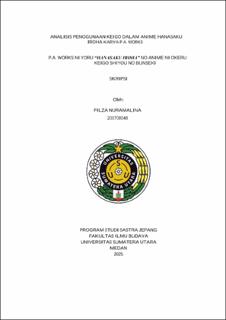| dc.description.abstract | This study analyzes the use of keigo in the anime Hanasaku Iroha by P.A. Works to
understand the application of the Japanese politeness system in the context of
animated media. The purpose of this study is to describe various keigo expressions
such as sonkeigo, kenjougo, and teineigo and the use of each keigo in the anime
Hanasaku Iroha. The theories used in this study are the keigo theory and the uchisoto theory. The method used in this study is a qualitative method. The data
collection technique used is the library method of observation and note-taking. The
results of this study show that in the anime Hanasaku Iroha, there are 2 sonkeigo
expressions, 9 kenjougo expressions, and 1 teineigo expression. Kenjougo is the
most commonly found keigo and consists of various expressions, such as 申し訳ご
ざいません (Moushiwake gozaimasen), 失礼します (Shitsurei shimasu), and 行
って参ります (ittemairimasu). Sonkeigo is found in the form of expressions such
as いらっしゃいませ (irasshaimase) and ようこそいらっしゃいました
(Youkoso irasshaimashita). Teineigo also appears in expressions such as 預かっ
てもらえませんか (azukatte moraemasenka). The use of keigo in the context of
Japanese inns reflects the concept of uchi-soto, where inn staff (uchi) use keigo
when interacting with guests (soto). Thus, this study shows that there are
expressions and uses of keigo in the anime Hanasaku Iroha. | en_US |


